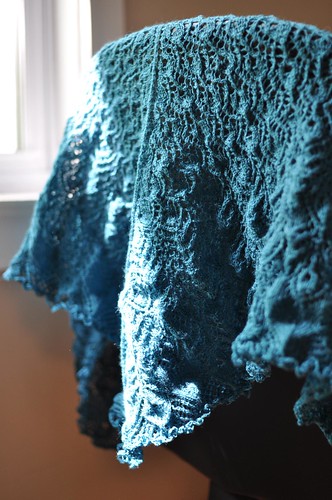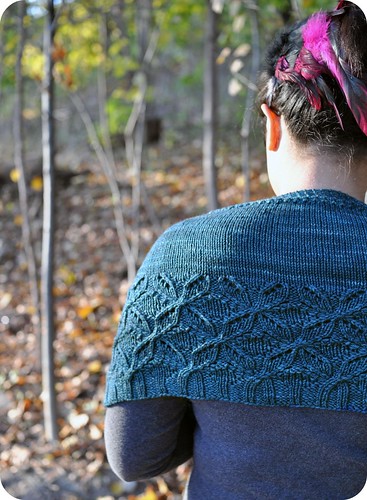Finally! More than two years since I started it, I finally got up the energy to finish it up. Of course, it still needs a good bath and blocking. Here are some “before” photos – it still looks pretty awesome, even unblocked.


As every knitter knows, the most difficult packing task is deciding on the knitting – how many projects, how much yarn, and what if you need that tool you hardly ever use? What if you RUN OUT OF YARN?
When packing for TNNA this is compounded by the fact that it’s a needlecraft industry show and nearly everyone you meet is a knitter, or at least knows a lot about yarn! So your knitting projects are on display and everyone is looking and touching. The pressure is on! (Just kidding, fellow TNNA-ers. You’re all awesome and non-judgey.)
I packed cashmere.
A plainish pullover in some silvery grey Handmaiden 4ply 100% cashmere. Canadian representation, easy to knit while chatting and drinking, and oh-so-amazing. I got a good chunk of the sweater done while I was away. My only concern is that I only have 5 skeins of the yarn, and they’re only 50g each! I’ve knit a sweater in this yarn before, and I used 6 last time – but cashmere grows a fair amount with washing and wearing, and I think for this little sweater I should be fine. I’m almost up to the underarm with just 2 skeins, and the 3/4 sleeve I finished this week at home took about 40g. By my calculations, I’ll have about 70g, or more than 25% of the total yarn to use for the yoke. The second sleeve is my toss-in-my-bag knitting now.
Cashmere part 2 was my peacock feathers shawl:
If you’ve been reading this blog awhile, you miiiight remember that I originally started this shawl on my big trip to Asia in early 2009. Although looking back through my archives, I can’t remember if I actually posted about it. Anyway, I worked on it a bit then, and a bit when I got home, but then I put it down in favour of worky design stuff and because I didn’t really have the knitting energy left over to work on a project that requires a little more concentration and a lot of chart reading.
I’ve decided that I will get this shawl off the needles soon, preferably earlier rather than later, so I took it for the 5 hour plane rides between Toronto and LAX. I figured I might actually put in some time on it, and I managed to get through about 1.5 of the charts. I was even able to watch some movies on the plane and knit the shawl at the same time.
There are 7 charts for the body of the shawl, and then a big edging one. I’m about halfway through chart 6, and while the end might not quite be in sight yet, at least it’s looking like I’ll be able to finish it! I’m knitting it in some laceweight cashmere that I bought a couple of Rhinebecks ago, on 2.25mm needles. The pattern calls for 3.5mm, but I want it to be smaller than 88″ across the top. So far it looks like it isn’t going to be enormous, so I’m pleased.
But it might be difficult to keep working away on this since I came back with so much lovely yarn that is tempting me towards some new projects.
The Tower Mill Shawl is a versatile shawl or wide scarf, beginning with an innovative garter stitch border cast on and shaped with short rows for a subtle curve. Tower Mill also incorporates a fun lace and cable pattern reminicient of windmill sails which flows into the clean ribbed edge.
Technical Editing by Jaya Purswani.
SIZE
58” / 147cm along top edge, 11.5” / 29cm deep at center
MATERIALS
Madelinetosh Tosh DK (100% superwash merino; 225 yds / 206m per 4oz / 113 g skein) Colour: Norway Spruce, 3 skeins or 675 yards / 618m of DK or worsted weight yarn
US 7 / 4.5mm circular needles 40” / 100cm or longer tapestry needle cable needle stitch markers (optional)
GAUGE
20 sts and 32 rows = 4” / 10cm square in Stockinette Stitch

PATTERN NOTES
Wrap begins at the top edge. The Garter Stitch border is worked at the same time as stitches are cast on for the full width of the shawl, resulting in a border which is perpendicular to the main body of the shawl. The stockinette portion of the shawl is shaped with short rows for a slightly curved wrap. Both charted and row-by-row directions are given for the Lacy Windmill Stitch.
Note that for the chart, odd numbered (RS) rows are read from right to left, and even numbered (WS) rows are read from left to right. All rows are charted.
MORE INFO
Skills Needed: cast on, knit, purl, lace, cables.
Pattern is a 4 page PDF file with full colour photos, written and charted directions for the Lacy Windmill stitch, and abbreviations list.
Available through Ravelry, payment through Paypal (no accounts required).